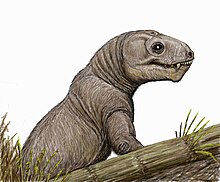| Biseridens Temporal range: Middle Permian,
| |
|---|---|

| |
| Life illustration of Biseridens qilianicus | |
| Scientific classification | |
| Domain: | Eukaryota |
| Kingdom: | Animalia |
| Phylum: | Chordata |
| Clade: | Synapsida |
| Clade: | Therapsida |
| Suborder: | †Anomodontia |
| Genus: | †Biseridens Li and Cheng, 1997 |
| Species: | †B. qilianicus
|
| Binomial name | |
| †Biseridens qilianicus Li and Cheng, 1997
| |
Biseridens ("two rows of teeth") is an extinct genus of anomodont therapsid, and one of the most basal anomodont genera known. Originally known from a partial skull misidentified as an eotitanosuchian in 1997, another well-preserved skull was found in the Qingtoushan Formation in the Qilian Mountains of Gansu, China, in 2009 that clarified its relationships to anomodonts, such as the dicynodonts.[1]
Among tetrapod taxa, the therapsid clade anomodontia in which Biseridens belong has one of the largest population sizes, highest levels of diversity, and longest stratigraphic range (Middle Permian to the Triassic, possibly into the Cretaceous), as well as being one of the only clades known from all the continents.[2][3] Primarily understood from the recently discovered, most-well preserved specimen, Biseridens is most notably distinguishable as an anomodont due to its short snout, dorsally elevated zygomatic arch, and presence of a septomaxilla that distinctly lacks a facial exposure between the nasal and maxilla.[1] The features that distinguish Biseridens from other anomodonts include the presence of heterodont dentition, or differentiated teeth rows in which different teeth have distinct morphology (ex. precanines, canines, molars, etc.), small toothlike projections, or denticles, located on the palatine and pterygoid, articulation between the opisthotic bone and the tabular bones on the posterior surface of the skull, the absence of the mandibular foramen on the lower jaw, and a pterygoid in which the transverse flange of the pterygoid has a laterally extending process but lacks posterior ramus.[1]
- ^ a b c Liu J, Rubidge B, Li J (January 2010). "A new specimen of Biseridens qilianicus indicates its phylogenetic position as the most basal anomodont". Proceedings. Biological Sciences. 277 (1679): 285–92. doi:10.1098/rspb.2009.0883. PMC 2842672. PMID 19640887.
- ^ Thulborn T, Turner S (May 2003). "The last dicynodont: an Australian Cretaceous relict". Proceedings. Biological Sciences. 270 (1518): 985–93. doi:10.1098/rspb.2002.2296. PMC 1691326. PMID 12803915.
- ^ King G (1990). The dicynodonts, A study in palaeobiology. Vol. 91. London: Chapman and Hall.